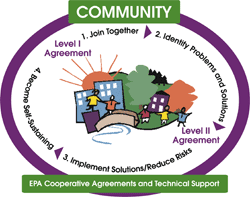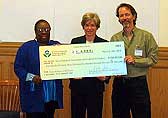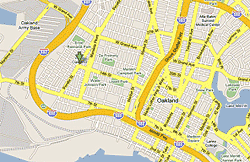Community Action for a Renewed Environment (CARE)
West Oakland Toxics Reduction Collaborative
Fall 2007

About CARE
Community Action for a Renewed Environment (CARE) is an EPA technical assistance and grant program that offers an innovative way for a community to organize and take action to reduce toxic pollution in the local environment.
Level I, Level II Grants
Awarded at two monetary levels, over two years, CARE grants help communities tackle their problems using a four-step process (see diagram below). Level I grants (up to $100,000) enable communities to progress through the first two steps, which are: 1) build a broad-based partnership and 2) identify a range of environmental problems and solutions. Level II grants (up to $300,000) fund the next two steps, which are: 3) take action to reduce risks and 4) become self-sustaining.
West Oakland, California, is a low income community of 25,000 people, 90 percent of whom are people of color. Since recovering from the 1989 Loma Prieta earthquake, the community has been on a trajectory of redevelopment. Occupying four square miles and entirely surrounded by freeways, the community is directly adjacent to the Port of Oakland, the fourth largest container port in the United States with throughput projected to triple by 2020. Despite facing economic, environmental, and social challenges, the community has maintained a culture of involvement and activism.

Step 1: Joining Together
Community members first joined together in 2000 to tackle environmental health conditions, forming the West Oakland Environmental Indicators Project (WOEIP). Out of that success grew the West Oakland Toxics Reduction Collaborative (the Collaborative), which was subsequently funded by EPA through a CARE Level II grant in September 2006. The WOEIP and EPA negotiated a joint partnering agreement, which includes having a community representative and an EPA staff person co-chair each action team and using a neutral facilitator. The Collaborative is open to all stakeholders, meets three times a year, has a paid neutral facilitator, and is coordinated by a steering committee. The Collaborative has formed eight action teams, each tackling a specific problem.
Step 2: Identifying Problems, Solutions
After reviewing West Oakland sources of toxic pollution with stakeholders, each of the eight action teams developed a work plan and goals and has been meeting to identify and implement toxic reduction efforts.

Deborah Jordan, EPA Air Division Director, center, giving CARE grant check to Margaret Gordon and Brian Beveridge of the West Oakland Environmental Indicators Project.
Step 3: Implementing Solutions, Reducing Risks
Overall, the teams have successfully taken on the challenge of addressing a wide range of West Oakland’s environmental impacts.
- The Indoor Air Team has surveyed and trained many residents in indoor air assessment and practices.
- The Healthy Home Team has been providing health impact assessments requested by residents and developers to implement best indoor air practices on a voluntary basis.
- The Alternative Fuels Team has helped convert more than a dozen heavy-duty trucks to compressed natural gas, and has developed a feasibility study for a biodiesel plant.
- The Truck Team has worked with the Port of Oakland in the first phase of an emissions reduction program that has grown from about 60 trucks to approximately 2,000 trucks.
- The Brownfields Team has transformed the state-run program into one overseen by the community as well. With community input, the team has developed a “roadmap” of the “brownfields process” in order to bring the community and implementing agencies together to resolve brownfields issues.
- The Land Use Team has targeted 30 to 70 acres of a closed army base to relocate and centralize port-related truck services outside of the community to reduce exposure to diesel pollutants.
- The Port Emission Reduction Team has targeted all emissions related to ports and is grappling with finding ways to meet the goal of reducing by 85 percent port-related diesel risk by the year 2020, as required by the state’s Emission Reduction Plan.

West Oakland, California
Step 4: Becoming Self-Sustaining
In the Collaborative, members “vote with their feet,”; one measure of sustainability is that, two years after their convening, the number of stakeholders and their productivity continues to grow. The WOEIP has also developed numerous funding sources in addition to EPA, with one team funded entirely by a state agency partner. A budget for sustaining the Collaborative has been developed and used in fundraising with partnering stakeholders. Beyond that, the Collaborative's strategy has always included as a goal the development of the capacity of the WOEIP and other community partners.
Partners
- AB Trucking Co.
- Alameda County Health Department
- Bay Area Air Quality Management District
- California EPA
- City of Oakland
- Federal, State and Local Elected Officials
- International Longshore and Warehouse Union
- Natural Resources Defense Council
- Pacific Gas and Electric Co.
- Pacific Institute
- Port of Oakland
- The International Brotherhood of Teamsters
- US EPA Region 9
- Union of Concerned Scientists
- University of San Francisco
- West Oakland Commerce Association
- West Oakland Environmental Indicators Project
- Many others
For Further Information
Please visit the CARE Web site for more information.
Richard Grow (grow.richard@epa.gov), US EPA Region 9 Project Lead
(415) 947-4104
Brian Beveridge, CARE Project Lead
West Oakland EIP
(510) 451-3227
